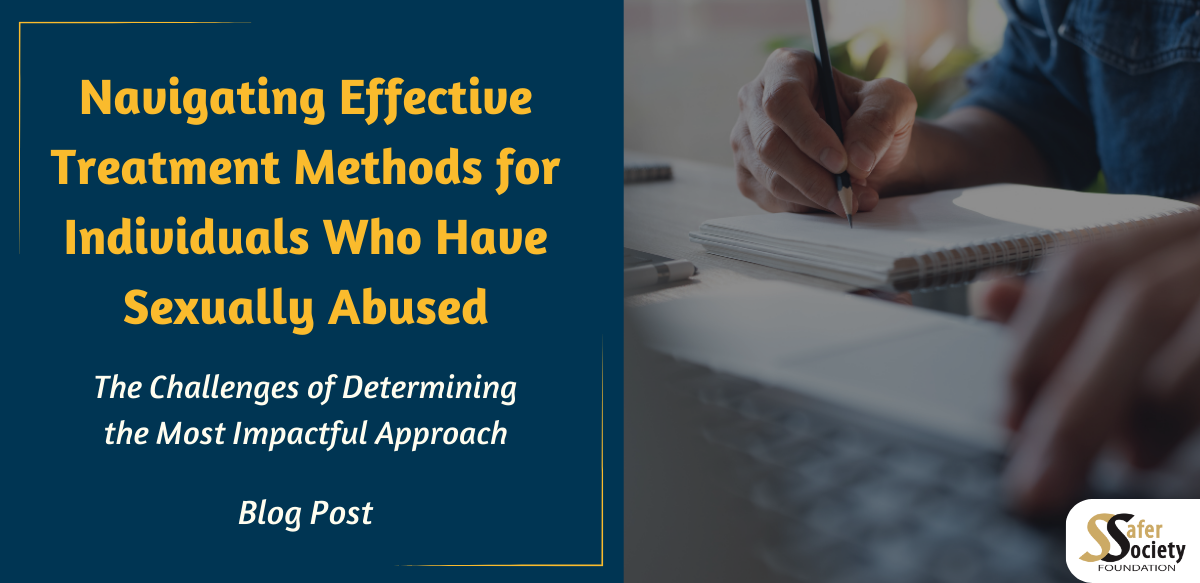
The Challenges of Determining the Most Impactful Approach
Clinicians and researchers who work with people who have sexually abused agree that treatment programs face an enormous challenge when it comes to demonstrating effectiveness. The search for effective treatment has resulted in a variety of approaches: strengths-based models, offense-focused models, cognitive-behavioral, insight-oriented, self-regulation models, and many more. How do clinicians determine which method has the best chance of impacting their clients?
There is a great deal of research on treatment programs that attempt to demonstrate effectiveness by looking at a variety of desired outcomes, such as:

- reduced recidivism rate
- the likelihood of re-offense
- the success of reintegration into the community
But how are these outcomes measured? Which outcomes provide the best evidence of success?
Grasping the strengths and weaknesses of the research methods used to evaluate the impact of these programs can be difficult. While randomized controlled trials are a powerful way to prove cause and effect, it is a tremendous challenge to perform this type of research in the real world with people who have harmed others. So, how can we come to solid conclusions from studies that are done in a more practical yet imperfect manner?
Robert J. McGrath, MA addresses these crucial questions in the training hosted by Safer Society on Thursday, January 25, 2024. During the training, attendees explore what to consider when deciding whether a treatment program can be successful and what it means to “weigh the evidence” of a program before adopting it into a therapeutic setting.
Effective Treatment Methods
Risk, Need, Responsivity Principles
The Risk-Need-Responsivity (RNR) model has received a great deal of research support regarding its effectiveness in reducing various types of recidivism. The model focuses on first identifying who is at greatest risk of re-offending by assessing factors such as age at first arrest, antisocial attitudes, and substance abuse. The need component is a recommendation that treatment address what are called “criminogenic needs:” those factors in an offender’s life that are related to offending behavior, and that can be changed (such as isolation from prosocial others and antisocial beliefs). Responsivity refers to how treatment programs should take into consideration each individual’s personality, abilities, and strengths.
Cognitive-Behavior Treatment (CBT) Models
Cognitive-Behavioral Therapy (CBT) is a therapeutic approach shown to reduce recidivism among offenders. The model is based on the belief that patterns of offending behavior can be changed through careful examination of how offenders view the world (cognitions) and the kinds of negative behaviors currently being reinforced in their lives. Changes in either of these factors can result in healthier life choices. CBT focuses on helping clients reduce cognitive distortions, improve perspective-taking skills, help to better manage emotional states, and impart strategies for creating healthy sexual and social relationships.
The Good Lives Model
The Good Lives Model takes a humanistic, strengths-based approach to offender treatment. The model is based on the belief that we all pursue similar goals in order to build a good life. These goals, referred to as “primary goods”, include experiencing excellence in play and work, inner peace, healthy relationships, involvement in our community, pleasure, and creativity. Unfortunately, people with problematic behaviors are unsuccessful in their pursuit of these goals, or they choose unhealthy and harmful ways to achieve them. Treatment focuses on skill-building as well as creating plans for fulfilling each of these primary goods in healthy ways. These plans include the identification of support systems that will help in achieving these goals.
Dialectical Behavior Therapy (DBT)
The DBT approach was originally developed to assist those who self-harm, have suicidal ideation, and those identified as suffering from borderline personality disorder. The focus of DBT is to help clients to identify and better manage their emotions. This is done through a highly structured approach that involves individual and group therapy, and the input of a therapist consultation team rather than just depending on the work of one therapist alone. It is a strengths-based approach, with a focus on helping clients practice and build skills not only in therapy but in their home environments as well. DBT also focuses on building the client’s motivation to change and, similar to the GLM model, determine how they can lead a more fulfilling life.
A Focus on Best Practices
During the training, McGrath—one of the most experienced professionals in the field—shares the “best practices” he has uncovered over his years of practice and research. Participants will be better able to choose an approach that will likely be more successful and utilize program evaluation tools to collect valuable feedback. McGrath is the President of an international consulting practice for training, program evaluation, and research services. He is well known for his work on the Vermont Assessment of Sex Offender Risk (VASOR) scale and the Sex Offender Treatment Intervention and Progress Scale (SOTIPS).
